Microsoft Releases November 2022 Security Updates
This article is contributed. See the original author and article here.
This article is contributed. See the original author and article here.
This article is contributed. See the original author and article here.
We continue to expand the Azure Marketplace ecosystem. For this volume, 125 new offers successfully met the onboarding criteria and went live. See details of the new offers below:
Get it now in our marketplace | |
|---|---|
| .NET on CentOS Stream 8: This offer from AskforCloud provides .NET on CentOS Stream 8. .NET is an open-source developer platform created by Microsoft. With .NET, you can use multiple languages, editors, and libraries to build for the web, for mobile devices, for IoT, or for other uses. You can write .NET apps in C#, F#, or Visual Basic. | |
.NET on Debian 10: This offer from AskforCloud provides .NET on Debian 10. .NET is an open-source developer platform created by Microsoft. With .NET, you can use multiple languages, editors, and libraries to build for the web, for mobile devices, for IoT, or for other uses. You can write .NET apps in C#, F#, or Visual Basic. | |
| .NET on Debian 11: This offer from AskforCloud provides .NET on Debian 11. .NET is an open-source developer platform created by Microsoft. With .NET, you can use multiple languages, editors, and libraries to build for the web, for mobile devices, for IoT, or for other uses. You can write .NET apps in C#, F#, or Visual Basic. | |
.NET on openSUSE 15: This offer from AskforCloud provides .NET on openSUSE 15. .NET is an open-source developer platform created by Microsoft. With .NET, you can use multiple languages, editors, and libraries to build for the web, for mobile devices, for IoT, or for other uses. You can write .NET apps in C#, F#, or Visual Basic. | |
.NET on Red Hat Enterprise Linux 7: This offer from AskforCloud provides .NET on Red Hat Enterprise Linux 7. .NET is an open-source developer platform created by Microsoft. With .NET, you can use multiple languages, editors, and libraries to build for the web, for mobile devices, for IoT, or for other uses. You can write .NET apps in C#, F#, or Visual Basic. | |
.NET on Red Hat Enterprise Linux 9: This offer from AskforCloud provides .NET on Red Hat Enterprise Linux 9. .NET is an open-source developer platform created by Microsoft. With .NET, you can use multiple languages, editors, and libraries to build for the web, for mobile devices, for IoT, or for other uses. You can write .NET apps in C#, F#, or Visual Basic. | |
.NET on SUSE Enterprise Linux 12: This offer from AskforCloud provides .NET on SUSE Enterprise Linux 12. .NET is an open-source developer platform created by Microsoft. With .NET, you can use multiple languages, editors, and libraries to build for the web, for mobile devices, for IoT, or for other uses. You can write .NET apps in C#, F#, or Visual Basic. | |
.NET on SUSE Enterprise Linux 15: This offer from AskforCloud provides .NET on SUSE Enterprise Linux 15. .NET is an open-source developer platform created by Microsoft. With .NET, you can use multiple languages, editors, and libraries to build for the web, for mobile devices, for IoT, or for other uses. You can write .NET apps in C#, F#, or Visual Basic. | |
.NET on Ubuntu Server 18.04 LTS: This offer from AskforCloud provides .NET on Ubuntu Server 18.04 LTS. .NET is an open-source developer platform created by Microsoft. With .NET, you can use multiple languages, editors, and libraries to build for the web, for mobile devices, for IoT, or for other uses. You can write .NET apps in C#, F#, or Visual Basic. | |
.NET on Ubuntu Server 20.04 LTS: This offer from AskforCloud provides .NET on Ubuntu Server 20.04 LTS. .NET is an open-source developer platform created by Microsoft. With .NET, you can use multiple languages, editors, and libraries to build for the web, for mobile devices, for IoT, or for other uses. You can write .NET apps in C#, F#, or Visual Basic. | |
.NET on Ubuntu Server 22.04 LTS: This offer from AskforCloud provides .NET on Ubuntu Server 22.04 LTS. .NET is an open-source developer platform created by Microsoft. With .NET, you can use multiple languages, editors, and libraries to build for the web, for mobile devices, for IoT, or for other uses. You can write .NET apps in C#, F#, or Visual Basic. | |
.NET on Windows Server 2012 R2: This offer from AskforCloud provides .NET on Windows Server 2012 R2. .NET is an open-source developer platform created by Microsoft. With .NET, you can use multiple languages, editors, and libraries to build for the web, for mobile devices, for IoT, or for other uses. You can write .NET apps in C#, F#, or Visual Basic. | |
.NET on Windows Server 2016: This offer from AskforCloud provides .NET on Windows Server 2016. .NET is an open-source developer platform created by Microsoft. With .NET, you can use multiple languages, editors, and libraries to build for the web, for mobile devices, for IoT, or for other uses. You can write .NET apps in C#, F#, or Visual Basic. | |
.NET on Windows Server 2022: This offer from AskforCloud provides .NET on Windows Server 2022. .NET is an open-source developer platform created by Microsoft. With .NET, you can use multiple languages, editors, and libraries to build for the web, for mobile devices, for IoT, or for other uses. You can write .NET apps in C#, F#, or Visual Basic. | |
.NET SDK on Debian 10: This offer from AskforCloud provides a .NET software development kit (SDK) on Debian 10. The kit includes everything you need to build and run .NET applications. .NET is an open-source developer platform created by Microsoft. | |
.NET SDK on Debian 11: This offer from AskforCloud provides a .NET software development kit (SDK) on Debian 11. The kit includes everything you need to build and run .NET applications. .NET is an open-source developer platform created by Microsoft. | |
.NET SDK on openSUSE 15: This offer from AskforCloud provides a .NET software development kit (SDK) on openSUSE 15. The kit includes everything you need to build and run .NET applications. .NET is an open-source developer platform created by Microsoft. | |
AI Signature Recognition: AI Signature Recognition from Cogniware uses algorithms and computer vision to verify the authenticity of signatures. Easily verify thousands of paper-based customer signatures. A demo version and a full version are available. The full version include automatic processing of photos and an implementation in your environment. | |
AllegroGraph 7.3.0: AllegroGraph is a multi-modal graph and document database that supplies foundational structure for scalable enterprise knowledge graphs. Thanks to its database security, AllegroGraph is fit for HIPAA access controls, privacy rules for banks, and security models for policing, intelligence, and government. | |
Azure CLI on Red Hat Enterprise Linux 9: This offer from AskforCloud provides the Azure Command-Line Interface (CLI) on Red Hat Enterprise Linux 9. The cross-platform tool allows you to connect to Azure and execute administrative commands through a terminal using interactive command-line prompts or a script. | |
Azure CLI on Windows Server 2012 R2: This offer from AskforCloud provides the Azure Command-Line Interface (CLI) on Windows Server 2012 R2. The cross-platform tool allows you to connect to Azure and execute administrative commands through a terminal using interactive command-line prompts or a script. | |
Azure CLI on Windows Server 2016: This offer from AskforCloud provides the Azure Command-Line Interface (CLI) on Windows Server 2016. The cross-platform tool allows you to connect to Azure and execute administrative commands through a terminal using interactive command-line prompts or a script. | |
Azure CLI on Windows Server 2019: This offer from AskforCloud provides the Azure Command-Line Interface (CLI) on Windows Server 2019. The cross-platform tool allows you to connect to Azure and execute administrative commands through a terminal using interactive command-line prompts or a script. | |
Azure CLI on Windows Server 2022: This offer from AskforCloud provides the Azure Command-Line Interface (CLI) on Windows Server 2022. The cross-platform tool allows you to connect to Azure and execute administrative commands through a terminal using interactive command-line prompts or a script. | |
Azure Virtual Desktop on Ubuntu 22.04 for Developers: This offer from Ntegral provides Ubuntu 22.04 on a Microsoft Azure virtual machine. The desktop image comes preconfigured with Visual Studio Code, Git, and LibreOffice, an open-source office suite that’s compatible with Microsoft Office. | |
Cassandra on Debian 10: This offer from AskforCloud provides Apache Cassandra on Debian 10. Cassandra is an open-source NoSQL distributed database trusted by thousands of companies for scalability and high availability. Cassandra enables developers to scale their databases dynamically, using off-the-shelf hardware, with no downtime. | |
Cassandra on Debian 11: This offer from AskforCloud provides Apache Cassandra on Debian 11. Cassandra is an open-source NoSQL distributed database trusted by thousands of companies for scalability and high availability. Cassandra enables developers to scale their databases dynamically, using off-the-shelf hardware, with no downtime. | |
Confidencial Encryption Technology: Confidencial’s selective encryption technology allows you to embed protected content within your Office documents and Microsoft Teams messages that’s viewable only by the individuals or groups you designate. Thus, you could create a document that contains portions visible only to HR, with other portions visible only to your legal department. | |
Ctelo Office Connect for Microsoft Teams: Ctelo Office Connect is an add-on to Ctelo Business Phone that connects offices based in countries with strict telecom regulations. This makes it possible to deploy a global telephony solution based on Microsoft Teams. | |
Ctelo Voice Channel for Microsoft Dynamics: Ctelo Voice Channel for Dynamics 365 Customer Service enables representatives to resolve customer service issues via phone. Part of the Ctelo Business Phone offering, Ctelo Voice Channel makes it possible to use the existing company telecom contract and phone numbers in both Microsoft Teams and Microsoft Dynamics. | |
Docker on AlmaLinux 8: This offer from AskforCloud provides Docker Community Engine on AlmaLinux 8. Docker is a platform that enables developers and system administrators to build, run, and share applications with containers. | |
Docker on AlmaLinux 9: This offer from AskforCloud provides Docker Community Engine on AlmaLinux 9. Docker is a platform that enables developers and system administrators to build, run, and share applications with containers. | |
Docker on Oracle Linux 8: This offer from AskforCloud provides Docker Community Engine on Oracle Linux 8. Docker is a platform that enables developers and system administrators to build, run, and share applications with containers. | |
Docker on Rocky Linux 8: This offer from AskforCloud provides Docker Community Engine on Rocky Linux 8. Docker is a platform that enables developers and system administrators to build, run, and share applications with containers. | |
Docker on Ubuntu 22.04: This offer from AskforCloud provides Docker Community Engine on Ubuntu 22.04. Docker is a platform that enables developers and system administrators to build, run, and share applications with containers. | |
env0 Pro: DevOps engineers, infrastructure-as-code developers, and site reliability engineers can use env0 to automate Terraform and Terragrunt Git flows, simplify the governance of cloud deployments, and manage the provisioning of teams, users, and environments. | |
Fedora 36 Desktop: This offer from Ntegral provides Fedora 36 on a Microsoft Azure virtual machine. The desktop image comes preconfigured with Visual Studio Code, Git, and LibreOffice, an open-source office suite that’s compatible with Microsoft Office. | |
Foxit eSign: Foxit eSign, an electronic signature tool, lets you quickly and easily prepare, send, sign, and track legally binding documents and agreements. Foxit eSign also can automate workflows. When you add Foxit eSign to Microsoft 365 and SharePoint, you can maximize document completion within your standard workflows. | |
Locust, Packaged by Data Science Dojo: This offer from Data Science Dojo provides Locust on Ubuntu 20.04. Locust is an open-source load-testing framework for web apps. It’s based on Python and is used for quality assurance processes. Through Locust, web testers can determine the potential of a website to withstand a number of concurrent users. | |
MetaSpark: Useful for project management, IT support, customer relationship management, or onboarding, MetaSpark consolidates tasks in one unified workspace. As teams deliver on their work, they can be recognized and rewarded based on company goals. | |
Oracle 8.5 Minimal: This offer from Art Group provides an image of Oracle 8.5 built with a minimal profile. It contains just enough packages to run Oracle 8.5 within Microsoft Azure, bring up an SSH Server, and allow users to log in. Integrated cloud tools and technologies simplify infrastructure deployment. | |
PULSE: Delivery deadlines are getting tighter for all storytellers, whether you’re a studio or a production company. By using PULSE, production teams and vendors will benefit from automation tools, a central storage location, and a collaborative workspace. Pull, transcode, and deliver production content to all your creative teams without data wrangling or manual file transfers. | |
Red Hat Enterprise Linux 8.6 Desktop: This offer from Ntegral provides Red Hat Enterprise Linux 8.6 on a Microsoft Azure virtual machine. The desktop image comes preconfigured with an RDP-based remote desktop environment and LibreOffice, an open-source office suite that’s compatible with Microsoft Office. | |
Rocky Linux 9 Desktop “Blue Onyx”: This offer from Ntegral provides Rocky Linux 9 on a Microsoft Azure virtual machine. The desktop image comes preconfigured with an RDP-based remote desktop environment and LibreOffice, an open-source office suite that’s compatible with Microsoft Office. | |
Siemens NX: Siemens NX on Microsoft Azure lets you run your CAD tools on the cloud. NX is built on a flexible and extensible architecture, and it supports working from home, from the office, or a remote location with secure and uninterrupted access. | |
Spark on Debian 10: This offer from AskforCloud provides Apache Spark on Debian 10. Apache Spark is an open-source analytics engine for executing data engineering, data science, and machine learning on single-node machines or clusters. It supplies high-level APIs in Java, Scala, Python, and R, along with an optimized engine that supports general execution graphs. | |
Spark on Debian 11: This offer from AskforCloud provides Apache Spark on Debian 11. Apache Spark is an open-source analytics engine for executing data engineering, data science, and machine learning on single-node machines or clusters. It supplies high-level APIs in Java, Scala, Python, and R, along with an optimized engine that supports general execution graphs. | |
Spark on Ubuntu Server 18.04 LTS: This offer from AskforCloud provides Apache Spark on Ubuntu Server 18.04 LTS. Apache Spark is an open-source analytics engine for executing data engineering, data science, and machine learning on single-node machines or clusters. It supplies high-level APIs in Java, Scala, Python, and R, along with an optimized engine that supports general execution graphs. | |
Spark on Ubuntu Server 22.04 LTS: This offer from AskforCloud provides Apache Spark on Ubuntu Server 22.04 LTS. Apache Spark is an open-source analytics engine for executing data engineering, data science, and machine learning on single-node machines or clusters. It supplies high-level APIs in Java, Scala, Python, and R, along with an optimized engine that supports general execution graphs. | |
VenueArc – Event Management: VenueArc streamlines event and venue management operations to help performing arts professionals increase accessibility, collaboration, productivity, and profitability. It features CRM integration, a contract generator, single sign-on through Azure Active Directory, and a pay-as-you-go model. | |
Go further with workshops, proofs of concept, and implementations | |
| Airport Analytics: 6-Week Proof of Concept: In this proof of concept, Glorious Insight will deliver its airport analytics platform on Microsoft Azure and assist in user adoption to drive successful outcomes. The platform will provide accurate collection of key performance indicators. | |
App of the Future Greenfield Envisioning & Design: 5-Day Workshop: InCycle’s App of the Future offer provides a Microsoft-funded engagement to quickly envision, prototype, and design an app on Azure. InCycle will conduct a design workshop to uncover your top business objectives, then create a rapid Azure prototype and reference architecture design. | |
Azure Arc Deployment: 1-Day Workshop: In this workshop, Chrisons will demonstrate how to manage, secure, develop, and operate infrastructure, apps, and Azure services. Participants will learn how to centrally manage a wide range of resources, including Windows and Linux servers, SQL Server, Kubernetes clusters, Azure Arc, and other Azure services. | |
Azure Database Migration: 1-Week Implementation: Start your journey to Microsoft Azure with PetaBytz’s migration service. PetaBytz’s team of experts will move your database assets to Azure so you can meet key business demands, such as scale, uptime, security, automation, and data insight innovation. | |
Azure DevOps, GitHub, and DevSecOps Workshops: Achieve a DecSecOps culture in your organization with Azure DevOps and GitHub. Over the course of a few workshops, DevTools will help your team adopt Azure DevOps and GitHub to achieve CI/CD features and application security in a DevSecOps workflow. | |
Azure Optimization: 2-Hour Workshop: This workshop from Cloud Direct will tell you why and how to align your Azure environment to the Microsoft Azure Well-Architected Framework. You’ll be able review your Azure environment for opportunities to reduce spending, increase security, and boost technical performance. | |
Azure Site Recovery Implementation: SVA will set up Azure Site Recovery to keep your applications operational during planned or unexpected outages. Azure Site Recovery provides you with replication, failover, and recovery processes. This offer is available only in German. | |
Azure Stack HCI: 2-Day Workshop: Chrisons will show you how Azure Stack HCI works and how to implement relevant solutions, such as enabling servers or centralized cloud management. Azure Stack HCI is built to accommodate everything from a small, two-node deployment to a 16-node deployment spread across offices and datacenters around the world. | |
Azure Stack HCI: 3-Hour Workshop: This workshop from Greeneris will introduce you to Azure Stack HCI and the benefits it can bring to your organization. Azure Stack HCI is a hyperconverged infrastructure cluster solution that hosts virtualized Windows and Linux workloads and their storage in a hybrid environment that combines on-premises infrastructure with cloud services. | |
Azure Synapse and Power BI: 6-Week Pilot Implementation: KiZAN will deploy a pilot implementation of a modern data platform, provide opportunities to work with Microsoft Power BI and Azure Synapse in your production environment, and develop a plan to assist with a full production deployment of Power BI and Azure Synapse. | |
Azure Virtual Desktop Implementation and Support: TOSYS will set up Azure Virtual Desktop so your company can try it out in small-scale or large-scale production use. Azure Virtual Desktop can be used for telework, regardless of whether the device is a PC or a smartphone. This service is available only in Japanese. | |
CFO Cockpit Package for Financial Analysis: Using Microsoft Power BI, Polestar will create a dashboard that will give you a bird’s-eye view into your company’s financial performance. Analysis typically covers a profit and loss statement, a balance sheet, accounts receivable, accounts payable, and inventory. | |
Churn Prediction Software Implementation: Using Azure Machine Learning, Polestar can help you identify employees with a greater likelihood of leaving your company. Being aware of the underlying parameters that could be responsible for attrition will give you the flexibility and time to act accordingly. | |
CI/CD Pipeline Implementation (5 Weeks): In this implementation, Linnovate will create a continuous integration/continuous delivery (CI/CD) pipeline for a single containerized application in an existing Kubernetes environment using Azure DevOps. | |
Course to Implement Microsoft Sentinel: This course from Nebulan, available in Spanish, will give you practical experience in implementing Microsoft Sentinel. Participants will learn about threat detection, incident management, automation, and workbooks. | |
Custom Application Development with Azure: Zure’s team will assist your company with application development using Microsoft Azure Platform as a Service technologies, which feature modern architecture choices and DevOps practices. Zure offers concept design services, application development, application support, and everything in between. | |
Implementation of Azure Services: SEIDOR will implement Microsoft Azure services to help your business be more profitable and competitive. You’ll receive business continuity and optimization of systems and applications, investigation of cyber threats, and secure desktop and application delivery from any device and any location. | |
IoT Apps Using PaaS: 2-Month Proof of Concept: Internet Initiative Japan Inc. will support customers’ IoT environment development with Azure Platform as a Service, licensing provisions, network functions, and selection of IoT devices. This service is available only in Japanese. | |
LTI Sustainable Smart Spaces: 12-Week Implementation: LTI will implement its connected-building solution, which includes sensors and uses numerous Azure services, so your organization can optimize building performance and align to environmental and sustainability goals. | |
Modern Secure Datacenter: 10-Day Implementation: Abtis specializes in managed security services for medium-sized companies. In this engagement, Abtis will provide cloud security management, cloud workload protection, and network security through various Azure services. This offer is available only in German. | |
PetaMigrate: 3-Day Workshop: Learn about PetaBytz’s cloud adoption framework in this workshop, which will include an assessment of your organization’s IT landscape and guidance for a migration to Microsoft Azure. PetaBytz can enable you to adopt Azure services with minimal downtime. | |
Power Move to Azure with Skytap: Using Skytap, Kyndryl will migrate your IBM AIX Power workloads to Microsoft Azure. Kyndryl provides production-ready preintegrated offerings that cover all transformation needs: strategy, development, migration, modernization, and management. | |
Predictive Order Management System: 8-Week Implementation: Having a lean, efficient supply chain is vital for manufacturing, distribution, or retail businesses. In this engagement, Datamind will implement an AI-based predictive order management system to improve your supply chain efficiency and deliver daily order recommendations. | |
Privileged Identity Management Jump-Start: Steeves and Associates will discuss the Privileged Identity Management service of Azure Active Directory, determine your company’s business and technical objectives, deliver a workshop to plot out an implementation, and conduct an IT operations training. | |
Sales Forecasting Implementation: Using Microsoft Power BI dashboards and data engineering with Python and Azure Data Factory, Polestar will forecast your sales over a specified period of time. This implementation is appropriate for retail stores, consumer packaged goods companies, or insurance agents. | |
Secure App and Internet Gateway: 6-Week Implementation: LAB3 will deploy a secure internet gateway in your tenant to provide round-the-clock visibility and threat management that meets the protection standards of the Infosec Registered Assessors Program (IRAP). IRAP is governed and administered by the Australian Cyber Security Centre. | |
Shield One Managed Security Service (1 Year): Get a bird’s-eye view of your cybersecurity with the security information and event management capabilities of Microsoft Sentinel. Signal Alliance can connect your Microsoft 365 suite and all other security tools to its Shield One managed service. This will provide continual monitoring and incident response for your enterprise platforms. | |
Well-Architected: Public Cloud Security Posture Workshop: Elisa’s experts will introduce the security posture management and workload protection capabilities of Microsoft Defender for Cloud. You’ll later get an assessment of your public cloud security, followed by recommendations. Continuous posture monitoring by Elisa is available as an option. | |
Contact our partners | |
| 9A Connected Factory & Insights | |
Aruba EdgeConnect Enterprise in Azure Virtual WAN | |
Automate Information Extraction from Images/Videos Using AI | |
Azure and Microsoft 365 License Consultancy: 4-Day Assessment | |
Azure Arc Hybrid Managed Services | |
Azure DevOps: 1-Week Assessment | |
Azure Virtual Desktop: 3-Day Assessment | |
CB Blockchain Seal for SharePoint | |
Cerberus – Domain Analysis: 3-Month Assessment | |
Cloud Migration Readiness: 2-Week Assessment | |
Custom Software Development: 2-Day Assessment | |
Data Modernization Discovery: 3-Day Assessment | |
EasyGov: Delivering Convenience & Transforming Governance | |
Enow’s Monitoring and Reporting for Microsoft 365 | |
Exodus EMM Migration to Microsoft Intune | |
Eyeglass: Disaster Recovery Automation | |
Feelix: AI-Based Chronic Disease Management System | |
Managed Service and Shared SBC for Microsoft Teams | |
Move to Azure: 1-Week Assessment | |
Noibit’s Managed Service for Microsoft Sentinel | |
Power Finance: 1-Week Assessment | |
Predictive Safety Fatigue Management System | |
Sirus NGSI-LD Context Broker Web App | |
Software & Cloud Economics Assessment | |
Springboard: Infrastructure-as-Code Framework for Azure | |
| Unified Customer Intelligence | |
| Verizon 5G Edge | |
This article was originally posted by the FTC. See the original article here.
Brought to you by Dr. Ware, Microsoft Office 365 Silver Partner, Charleston SC.
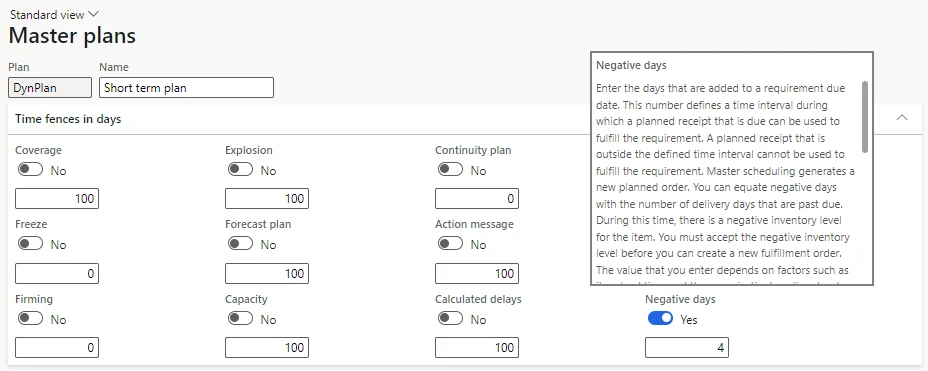
This article is contributed. See the original author and article here.
New make-to-order (MTO) automation capabilities available with the October 2022 release of Dynamics 365 Supply Chain Management streamline order-taking and related downstream processes. Supply chain planners can benefit from improved capable-to-promise (CTP) accuracy with plan-specific delay tolerance, keep supply available for last-minute orders, and automatically populate external order information during intercompany trade.
With MTO, production only starts after a customer places an order for a specific product. The main benefits of MTO are that you can accommodate customer-specific products and you don’t need to keep inventories of finished goods with the related risk of wastage. However, with MTO, your delivery time includes the production lead time and depends on the availability of resources and raw materials. This often leads to the need for CTP, close tracking of resource capacity, and flexibility for last-minute orders.
Until now, supply chain planners had to monitor and adjust supply levels and current demand manually. With the new automation capabilities in Supply Chain Management, planners can automate these tasks. The system takes informed actions based on parameters they set.
Let’s take a closer look at the benefits of six improvements we’ve made for make-to-order scenarios.
Delay tolerance represents the number of days beyond the lead time that you’re willing to wait before you order new replenishment when existing supply is already planned. It helps you avoid creating new supply orders if the existing supply will be able to cover the demand after a short delay. With the new Negative days option for delay tolerance control, you can determine whether it makes sense to create a new supply order for a given demand. The ability to control delay tolerance at the master plan level gives you more flexibility between the static plan and the dynamic plan used for CTP calculations. Automating the process ensures that CTP calculations don’t allow delays. You can optimize refill orders on the static plan to use existing orders, even it causes a bit of delay.

The Use latest possible supply option lets you keep products available for last-minute orders. It optimizes the use of existing supply by pegging the latest possible supply to a demand instead of using the first possible supply.
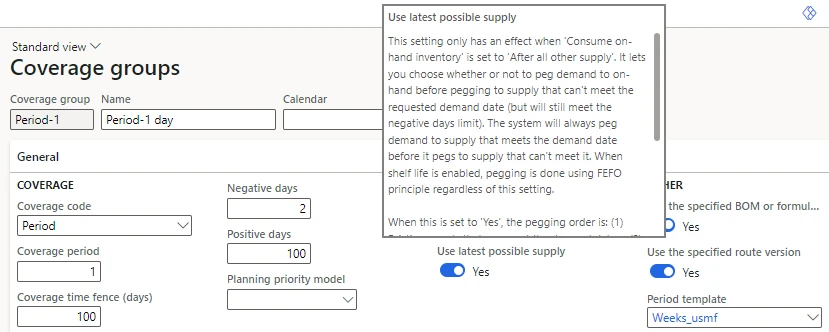
Marking links supply to demand for the purpose of cost allocation. It resembles pegging, which indicates how master planning expects to cover demand. However, marking is more permanent than pegging because it’s respected by later planning runs. Now you can limit inventory marking to a single level when firming planned orders. That allows you to keep component assignments flexible for production orders after firming.
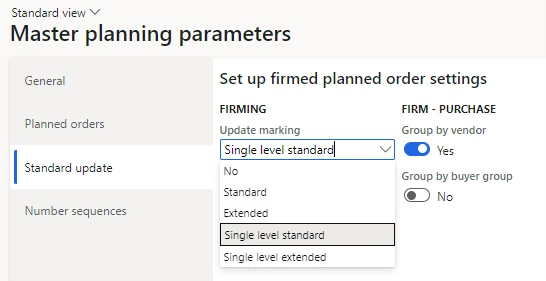
You can already set a global default fulfillment policy and then override it for specific customers. Now you can view which default policy applies directly on the order and override it for individual orders. Previously, the order taker had to manually change the policy on the sales order. Now this step is automated, giving more control to the order taker and enabling flexible order processing.
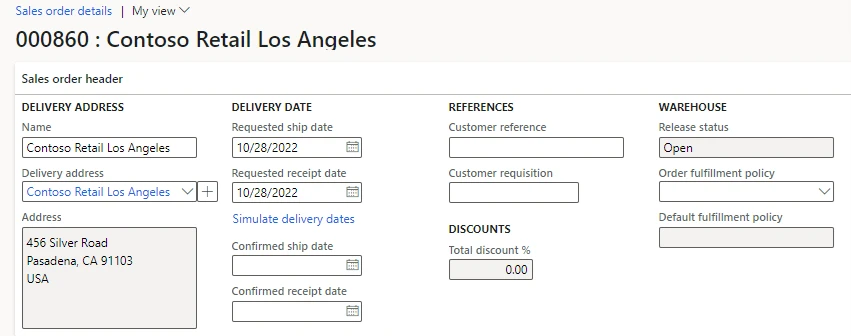
Delivery terms, mode of delivery, and external item numbers are critical information to track when one company receives a customer sales order, and another company ships the goods to the customer. Now purchase order lines are updated automatically to include this information from the intercompany sales order. This improvement enhances intercompany information exchange. It ensures that detailed demand information flows to the supplying company and that companies meet their customer commitments.
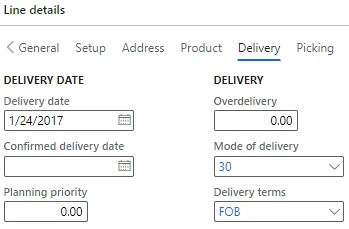
We’ve added a field to the Capacity load page. The new Number of days field allows you to define a custom period over which to view the capacity load of a resource, enabling long-term evaluation.
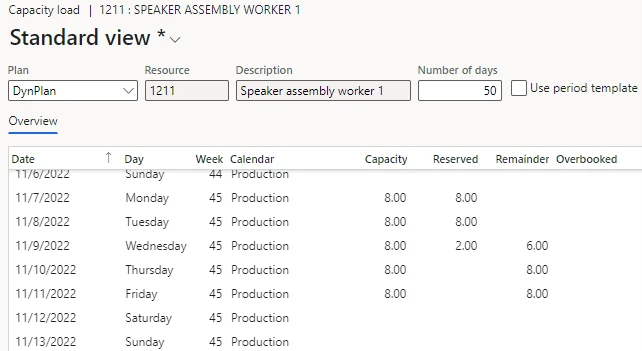
To learn more about MTO automation in Supply Chain Management, read the documentation: Make-to-order supply automation | Microsoft Learn.
For more information about the delay tolerance impact, read Delay tolerance (negative days) | Microsoft Learn.
For more information about the impact of marking when firming planned orders, read Inventory marking with Planning Optimization | Microsoft Learn.
The post Streamline your make-to-order supply chain appeared first on Microsoft Dynamics 365 Blog.
Brought to you by Dr. Ware, Microsoft Office 365 Silver Partner, Charleston SC.
This article is contributed. See the original author and article here.
In the recent pandemic, health institutions all across the world have been pushed to their limits on about every facet. Through this, many such institutions have begun to reprioritize their modernization efforts around their cloud infrastructure to support increasing demands and hedge against uncertainty. As institutions are migrating their existing workloads into the cloud, a common challenge they are faced with is that many of their on-prem security processes and standards tend to not map one-to-one with the services they are being migrated to. With the sensitive nature of the healthcare industry, it is especially important to solution feasible routes to always ensure security and validation is in place end-to-end.
In this blog post, we will look at how Azure DevOps Pipeline Decorators can be leveraged to bridge the gap in our cloud environment with the customer’s existing security processes on their on-premises IIS server.
If you have ever run across jobs executing on your azure pipelines that you have not previously defined, there is a good chance you may have already run into decorators before!
Pipeline decorators allow you to program jobs to execute before or after any pipeline runs across your entire Azure DevOps organization. For scenarios such as running a virus scan before every pipeline job, or any sort of automated steps to assist with governance of your CICD processes, pipeline decorators grants you the ability to impose your will at any scale within Azure DevOps.
Read further on decorators on Microsoft Learn: Pipeline decorators – Azure DevOps | Microsoft Learn
In this blog post, I will be walking through a sample process based on the customer scenario’s requirements, and how the pipeline decorators can fit in to assist with their governance objectives.
Customer’s Azure DevOps organization has grown to a considerable size composed of numerous projects with various applications with no clearly defined process or standards they adhere to. All of these applications have been hosted on an on-premises IIS server, where the application teams are trusted to provide manual inputs to deployment variables.
Due to the lack of out-of-the-box controls for validating IIS file path permissions with Azure Active Directory identities within Azure DevOps, this was an area of concern with the customer as the deployed production applications effectively did not have any preventative measures to address malicious actors or human error overwriting existing applications.
When looking at the deployment tasks to IIS servers from Azure DevOps, the two primary variables the customer was looking to control were:
virtualAppName– Name of an existing an already existing virtual application on the target machineswebsiteName– Name of an existing website on the machine groupConsidering the RBAC strategy the customer has in mind with AAD, there will be a third variable to represent the ownership of the application via an AAD group.
groupId– AAD ID of the application owner’s groupIn the next section, I will outline a high-level process proposal based on these three variables, that goes into onboarding applications.
For this demo’s purposes, we will make the following assumptions to build out a process that illustrates how application teams can successfully onboard and assist the operations team in successfully managing the application environment within their on-prem IIS server.
virtualAppNamegroupIdwebsiteName
Ops team provides a template (such as GitHub issues templates) for new application requests to the application teams, and captures the following IIS deployment-specific information:
virtualAppNamegroupIdwebsiteNameFor this demo, I have created a simple GitHub issues YAML form which the operations team can leverage to capture basic information from the application teams, which can also be tied to automation to further reduce operational overhead:
virtualAppName, groupId, websiteName values as secrets
virtualAppNamegroupIdwebsiteName
Now with the high-level process defined, we will now look at how we could bring in the relevant parameters into the decorators to impose validation logic.
In this example, I created a key vault named kv-demolocaldev, and placed the virtualAppName, groupId, and websiteName so we may retrieve the values later as shown below:
Now, we must create the project and subsequently create the service connection to the key vault scoped to the project.
To do this, I created an Azure Resource Manager Service Connection while using my demo identity, that is scoped to the resource group containing the key vault:
Once the service connection is done provisioning, you can navigate to the AAD object by following the Manage Service Principal link, which will allow you to retrieve the Application ID to be used when adding the access policy.
Selecting the Manage Service Principal link will take us to the AAD object, where we can find the Azure Application ID to add to our Key Vault access policy.
The service connection will only need GET secret permissions on its access policy.
Afterwards, we now capture the information about the service connection and key vault by creating a variable group on the application’s Azure DevOps project named demo-connection-details:
There will need to be additional steps taken to provision the IIS server as well with the parameters, but for this demo’s purpose we will assume that the provisioning steps have already been taken care of. Now with this, we can move onto building out our decorators.
For the pipeline side, the customer is looking to control both the pre-build with validating the input variables, and post-build in placing guardrails around deployment configurations with the validated parameters.
Both pre and post decorators will leverage the same key vault secrets, so we will start with integrating the key vault secrets into the YAML definition.
Pipeline decorators leverage the same YAML schema as the YAML build pipelines used within Azure DevOps. Meaning we can take advantage of conditional logic with repo branches, dynamic variables, and pull in key vault secrets with service connections.
The high-level logic we are attempting to demonstrate for the pre and post decorators are the following:
Pre:
Post:
You can find the demo files within the following repo: https://github.com/JLee794-Sandbox/ADO-Decorators-PoC
To ensure users can opt-out of the process during development, we can leverage the same YAML schema as build pipelines to construct our conditionals.
In the pre-build decorator YAML definition (located in Build/Pre/input-parameter-decorator.yml), for pipeline builds that run off the main branch, that also checks for a simple variable flag named testDecorator to be true for the decorator to execute.
steps:
– ${{ if and(eq(variables[‘Build.SourceBranchName’], ‘main’), contains(variables[‘testDecorator’],’true’) ) }}:
Following right after, I retrieve websiteName, groupId, and virtualAppName with the connection details we have placed within the demo-connection-details, which will be passed in by the build pipeline.
– task: AzureKeyVault@2
displayName: ‘[PRE BUILD DECORATOR] Accessing Decorator Params from the key vault – $(decorator_keyvault_name), using $(decorator_keyvault_connection_name) connection.’
inputs:
azureSubscription: $(decorator_keyvault_connection_name) # Service Connection Name (scoped to RG)
KeyVaultName: $(decorator_keyvault_name) # Key Vault Name
SecretsFilter: ‘websiteName,groupId,virtualAppName’ # Secret names to retrieve from Key Vault
RunAsPreJob: true
Now that the secrets have been pulled in, we can now run our custom validation logic for each. For the purpose of this demo, we will just check that each variable exists and throw an error through a simple PowerShell script.
– task: PowerShell@2
name: ValidateDeploymentVariables
displayName: ‘[PRE BUILD DECORATOR] Validate Deployment Variables (Injected via Decorator)’
inputs:
targetType: ‘inline’
script: |
$errorArr = @()
try {
Write-Host “VirtualAppName: $(virtualAppName)”
# your input test cases go here
# e.g querying the remote-machine to match the virtualAppName
}
catch {
errorArr += ‘virtualAppName’
Write-Host “##vso[task.logissue type=error]Input parameter ‘virtualAppName’ failed validation tests.”
}
try {
Write-Host “GroupID: $(groupId)”
# your input test cases go here
# e.g querying the remote-machine to match the groupId against the local file permissions
}
catch {
Write-Host “##vso[task.logissue type=error]Input parameter ‘groupId’ failed validation tests.”
errorArr += ‘GroupID’
}
try {
Write-Host “WebSiteName: $(webSiteName)”
# your input test cases go here
# e.g querying the web-site URL to see if site already exists, etc.
}
catch {
Write-Host “##vso[task.logissue type=error]Input parameter ‘webSiteName’ failed validation tests.”
errorArr += ‘GroupID’
}
if ($errorArr.count -gt 0) {
# Link to your teams documentation for further explanation
Write-Warning -Message “Please provide valid parameters for the following variables: $($errorArr.join(‘, ‘))”
Write-Warning -Message “See <https://docs.microsoft.com/en-us/azure/devops/pipelines/process/variables?view=azure-devops&tabs=yaml%2Cbatch> for additional details”
throw “Please provide valid values for $($errorArr.join(‘, ‘)).”
}
And we are done with the pre-build decorator! Of course, while developing it is important to iteratively test your code. If you would like to publish your code now, skip to the (Publish your extension) section below.
For our post-build decorator, all we want to do is determine when the decorator should run, and simply invoke a deployment task such as the IISWebAppDeploymentOnMachineGroup task.
Of course, there are many more validation steps and tools you can place here to further control your deployment process, but for the sake of this demo we will just be outputting some placeholder messages:
steps:
– task: PowerShell@2
name: DeployToIIS
displayName: Deploy to IIS (Injected via Decorator)
condition: |
and
(
eq(variables[‘Build.SourceBranch’], ‘refs/heads/main’),
eq(variables.testDecorator, ‘true’)
)
inputs:
targetType: ‘inline’
script: |
# Validation steps to check if IIS
# Validation steps to check if iOS or Android
# > execute deployment accordingly
Write-Host @”
Your IIS Web Deploy Task can look like this:
– task: IISWebAppDeploymentOnMachineGroup@
inputs:
webSiteName: $(webSiteName)
virtualApplication: $(virtualAppName)
package: ‘$(System.DefaultWorkingDirectory)***.zip’ # Optionally, you can parameterize this as well.
setParametersFile: # Optional
removeAdditionalFilesFlag: false # Optional
excludeFilesFromAppDataFlag: false # Optional
takeAppOfflineFlag: false # Optional
additionalArguments: # Optional
xmlTransformation: # Optional
xmlVariableSubstitution: # Optional
jSONFiles: # Optional
“@
First, we need to construct a manifest for the pipeline decorators to publish them to the private Visual Studio marketplace so that we may start using and testing the code.
In the demo directory, under Build we have both Pre and Post directories, where we see a file named vss-extension.json on each. We won’t go into too much of the details around the manifest file here today, but the manifest file allows us to configure how the pipeline decorator executes, and for what sort of target.
Read more on manifest files: Pipeline decorators – Azure DevOps | Microsoft Learn
With the manifest file configured, we can now publish to the marketplace and share it with our ADO organization:
Create publisher on the Marketplace management portal
Install tfx command line tool
npm install -g tfx-cliNavigate to the directory containing the vss-extension.json
Generate the .vsix file through tfx extension create
> tfx extension create –rev-version
TFS Cross Platform Command Line Interface v0.11.0
Copyright Microsoft Corporation
=== Completed operation: create extension ===
– VSIX: /mnt/c/Users/jinle/Documents/Tools/ADO-Decorator-Demo/Build/Pre/Jinle-SandboxExtensions.jinlesampledecoratorspre-1.0.0.vsix
– Extension ID: jinlesampledecoratorspre
– Extension Version: 1.0.0
– Publisher: Jinle-SandboxExtensions
Upload the extension via the Marketplace management portal or through tfx extension publish
Share your extension with your ADO Organization on the management portal
Install the extension on your ADO Organization
Now that your pipeline decorators are installed in your organization, any time you push an update to the Visual Studio marketplace to update your extensions, your organization will automatically get the latest changes.
To test your decorators, you can leverage the built in GUI for Azure DevOps to validate your YAML syntax, as well as executing any build pipeline with the appropriate trigger conditions we have configured previously.
In our demo application environment, I updated the out-of-the-box starter pipeline to include our connection variable group, as well as specify the testDecorators flag to true:
variables:
– name: testDecorator
value: true
– group: demo-connection-details
Running the pipeline, I can now see the tasks I have defined execute as expected:
Once we verify that the pre and post tasks have run as expected with the conditional controls evaluating in a similar manner, we can then conclude this demo.
Now with the decorator’s scaffolding in place, the customer can continue to take advantage of the flexibility provided by Azure DevOps pipeline’s YAML schema to implement their existing security policies at the organization level.
I hope this post helped bring understanding to how pipeline decorators can be leveraged to automate custom processes and bring governance layers into your ADO environment.
If you have any questions or concerns around this demo, or would like to continue the conversation around potential customer scenarios, please feel free to reach out any time.

This article is contributed. See the original author and article here.
We recently announced the unified Customer Service admin center, which consolidates administration experiences across the Microsoft Dynamics 365 Customer Service suite. The unified admin center simplifies setup tasks with a step-by-step guided experience to help admins easily onboard customer service channels. A dedicated search for settings makes discovering and updating settings fast and easy.
The guided setup wizard helps you configure customer service channels such as email, case, chat, and voice. The wizard guides you through all the steps to configure users and permissions and set up queues and routing rules to help you start handling customer issues with minimal fuss.

After all the steps are complete, you’ll find instructions to validate that the channel is set up correctly. You can also go directly to a step to modify settings.

The search admin settings page helps you quickly discover the admin setting you want to manage. Along with top matches, the page lists settings for new features, so that you can evaluate whether they might be helpful for your business and start to adopt them.

With the new unified Customer Service admin center, it’s easier than ever to manage users, add channels, route and distribute workloads, and get valuable insights about all the activity across your digital contact center. Migrate to the new app to discover how you can streamline digital contact center operations, help your agents be more productive, and earn customers for life.
To find out more about the new unified Customer Service admin center app, read the documentation: Customer Service admin center | Microsoft Learn
Not yet a Dynamics 365 customer? Take a guided tour and get a free trial.
The post Improve admin productivity with guided Customer Service channel setup and settings search appeared first on Microsoft Dynamics 365 Blog.
Brought to you by Dr. Ware, Microsoft Office 365 Silver Partner, Charleston SC.
This article is contributed. See the original author and article here.
In this guest blog post, Kajol Patel, Senior Content Marketing Specialist at Data Dynamics, discusses digital transformation strategies for enterprises and how to utilize StorageX and the Azure File Migration Program to overcome common data migration challenges.
Data is foundational to any digital transformation strategy, yet enterprises worldwide struggle to find reliable and cost-efficient solutions to manage, govern, and extract valuable insights from it. According to a recent report published in Statista, the total volume of enterprise data worldwide increased from 1 petabyte (PB) to 2.02 PB between 2020 and 2022. This sizeable jump in volume indicates a 42.2 percent average annual growth in data over the last two years. The report also highlights that a majority of that data is stored in internal datacenters. Data storage and processing is costly and energy-intensive for enterprises.
Additionally, the cost of software for collection, analysis, and management of terabytes and petabytes of data residing in multiple storage centers adds to the expenditure. Breaking down siloes to extract real-time insights often ends up costing the enterprise exorbitant amounts of IT resources and revenue.
As unstructured data sprawl continues to grow, enterprises are turning to the cloud and embracing data as a strategic and valuable asset. By extracting useful insights from data, businesses can accelerate their digital journey by making data-driven decisions in real time to meet peak demand, grow revenue, and minimize storage cost. Enterprises such as Microsoft that offer cloud solutions give clients access to subscription-based remote computing services. It enables them to adjust cloud consumption to meet changing needs. As a possible recession looms, organizations that rely on the cloud are more likely to experience cost reduction as they effectively manage risk and compliance.
However, most enterprises face numerous challenges while migrating to the cloud: proprietary vendor lock-in, lack of migration skills, a labor-intensive process, and inadequate knowledge of data estate.
Top 3 data migration challenges for enterprises:
In a webinar hosted by Data Dynamics, Karl Rautenstrauch, Principal Program Manager, Storage Partners at Microsoft, spoke about the top challenges faced by enterprise customers while migrating to the cloud: “Over nine years of working closely with partners and customers in the field of migrating datasets and applications to Azure, we see a consistent theme of every enterprise in every industry being a little overburdened today – too much to do, too little time, and too few people, hence most of these enterprises are seeking automation. They want to ensure that they can engage in complex activities like moving an application comprised of virtual machines, databases, and file repositories in the simplest way possible with the least risk possible.”
He further emphasized the most consistent requirement for all customers he has worked with, regardless of size, was to migrate large data sets securely, quickly, and with minimal risk and disruption to user productivity.
Migrating file data between disparate storage platforms is always a daunting process. Microsoft recently announced the Azure File Migration Program to make customer data migration much easier and more secure. It helps address the customer’s need to reduce the time, effort, and risk involved in complex file data migration.
Speaking at the webinar, Rautenstrauch emphasized the value of on-demand compute and modern cloud services: “We have built a platform of services called Azure Migrate, which is freely available, and it has cloud-driven capabilities. These services help customers move virtual machines easily, databases, and now even containerized applications in an automated, risk-free fashion. One area that is neglected is unstructured data, so what we are going to do is address it in the Azure File Migration Program.”
The Azure Migrate hub offers many effective tools and services to simplify database and server migration but doesn’t address the need for unstructured data migration. Hence, Azure File Migration Program is becoming a new favorite among enterprises possessing unstructured data sprawl.
Jurgen Willis, VP of Azure Optimized Workloads and Storage, states in his blog, “Azure Migrate offers a very powerful set of no-cost (or low-cost) tools to help you migrate virtual machines, websites, databases, and virtual desktops for critical applications. You can modernize legacy applications by migrating them from servers to containers and build a cloud native environment.”
Data Dynamics transforms data assets into competitive advantage with Azure File Migration
With over a decade of domain experience and a robust clientele of 300+ organizations, including 28 of the Fortune 100, Data Dynamics is a partner of choice for unstructured file data migrations. StorageX is Data Dynamics’ award-winning solution for unstructured data management. The mobility feature of StorageX provides intelligence-driven, automated data migrations to meet the needs and scale of global enterprises.
Having migrated over 400 PB of data encompassing hundreds of trillions of files, this feature is trusted and proven and delivers without losing a single byte of data. It provides policy-based and automated data migration with reduced human intervention and without vendor lock-in. StorageX has proven capabilities to multi-thread and migrates at the speed where you can move millions and billions of files in hours, making it one of the most scalable and risk-free data migration solutions.
It can easily identify workloads and migrate data based on characteristics such as the least-touched files, files owned by specific users or groups, or hundreds of other actionable insights. StorageX Migration is a powerful migration engine that moves large volumes of data across shares and exports with speed and accuracy.
Here’s a detailed comparative study of StorageX versus traditional migration tools.
Microsoft is sponsoring the use of Data Dynamics’ StorageX as a part of the Azure File Migration Program. Enterprises can leverage this product to migrate their unstructured files, Hadoop, and object storage data into Azure at zero additional cost to the customer and no separate migration licensing.
Learn more about the Azure File Migration Program or reach us at solutions@datdyn.com I (713)-491-4298 I +44-(20)-45520800
This article is contributed. See the original author and article here.
Now more than ever, IT leaders need to reduce costs while securing and empowering their workforce. Microsoft 365 combines the capabilities organizations need in one secure, integrated experience—powered by data and AI—to help people work better and smarter.
The post Discover how Microsoft 365 helps organizations do more with less appeared first on Microsoft 365 Blog.
Brought to you by Dr. Ware, Microsoft Office 365 Silver Partner, Charleston SC.

This article is contributed. See the original author and article here.
In a recent keynote at Microsoft Inspire, Microsoft Chairman and CEO Satya Nadella made this prediction, “The next 10 years are not going to be like the last 10,” and that “Digital technology will be the only way to navigate the headwinds facing business leaders today.” Today, we face is a world of perpetual change with ever-increasing economic, environmental, and social complexities. This brings us to a cumulation of factors that profoundly impact the health and success of individuals and corporations. The opportunity facing business leaders is to find ways to utilize technology to drive a positive impact on business performance and the well-being of society and the environment.
It has become clear that ESG (environmental, social, and governance) initiatives are becoming a top business priority for many organizations. The Gartner annual CEO and Senior Business Executive Survey states, “In 2022, environmental sustainability became a top 10 business priority for the first time ever, with 9 percent of the respondents naming it as one of their top three.”1 This focus in priority is for good reason. Studies show that companies that execute effectively on ESG programs can reduce operating costs by up to 60 percent2 and that higher ESG scores correlate to lower costs of capital (6.16 percent compared to 6.55 percent for the lowest ESG scores).3
What is less clear is how businesses execute ESG initiatives in ways that do not require more effort or added expenseeffectively, how to do more with less. In his Microsoft Inspire keynote, Satya stated, “Doing more with less doesn’t mean working harder or longer. That’s not going to scale. But it does mean applying technology to amplify what you’re able to do across an organization so you can differentiate and build resilience.” The expectation that we must do more with less is especially relevant when actioning on ESG goals. The approach business leaders must consider is anything that reduces energy costs or increases resource efficiency will be highly beneficial to CEOs, customers, employees, investors, and the environment.
There are many ways to make ESG impact, and perhaps most attractive to business leaders are opportunities that align business processes to ESG outcomes. One very accessible possibility exists in the automation of paper-intensive business processes. For example, Accounts Payable (AP) has historically been plagued by the manual effort and cost required to manage tens of thousands of paper invoices. AP invoicing is heavy with storage, printing, disposal, and document security costs that can easily be mitigated through digitization.
Though the digitization of office paper has been achievable for over a decade, organizations still struggle to phase out paper-laden business processes. Some estimates show that US offices use 12.1 trillion sheets of paper annually and that demand for paper is expected to double before 2030.4 To address this trend, companies should turn to robust and easy-to-use technology to help quickly reduce paper usage.

If your organization is ready to embark on the journey to go paperless, Microsoft is here to help. We are excited to release the preview of Invoice capture within Microsoft Dynamics 365 Finance. Invoice capture will allow our customers to digitally transform the entire invoice-to-pay process within their AP departmentdelivering better spend control, faster cycle times, and paperless processing, leading to more automation and less waste. With the support of advanced technology, organizations can efficiently drive outcomes that benefit both business interests and the greater good.
Sources
1Gartner CEO and Senior Business Executive Survey.
GARTNER is a registered trademark and service of Gartner, Inc. and/or its affiliates in the U.S. and internationally and is used herein with permission. All rights reserved.
2Five Ways That ESG Creates Value, McKinsey.
3ESG and the Cost of Capital, MSCI.
4Paper Waste Facts, The World Counts.
The post Automate more, waste less: ESG initiatives with Dynamics 365 Finance appeared first on Microsoft Dynamics 365 Blog.
Brought to you by Dr. Ware, Microsoft Office 365 Silver Partner, Charleston SC.
This article is contributed. See the original author and article here.
Recent Comments